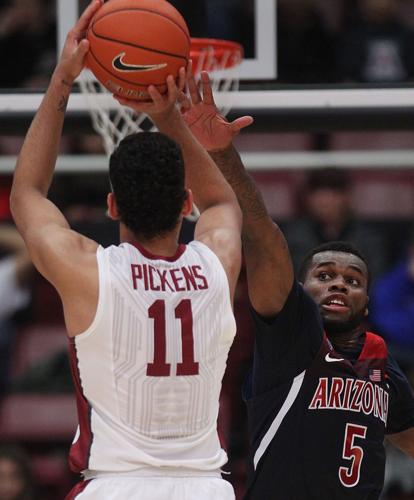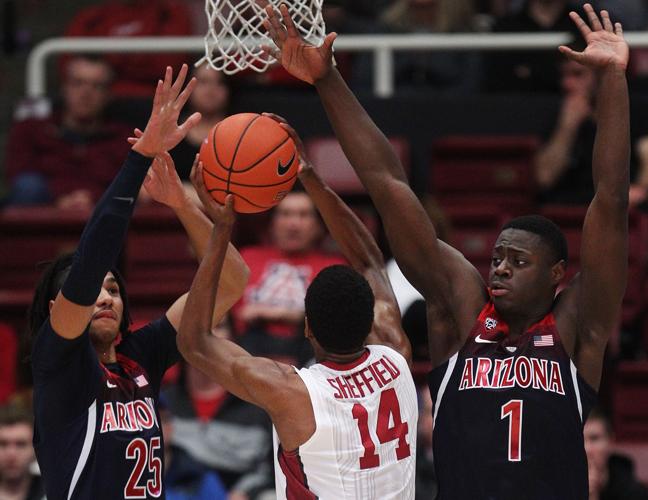Once Arizona coach Sean Miller finished scrambling to gather another Top 5 recruiting class last spring, the accolades gushed in.
Lauri Markkanen: Remarkably skilled 7-foot stretch four. Kobi Simmons: Wildly athletic shooter. Rawle Alkins: Power offense. Keanu Pinder: Hard-charging rebounder.
Underlined nowhere, except secondarily in Pinder’s case, was the word “defense.”
Yet the Wildcats will reach the halfway point of the regular season after their game with Utah on Thursday at McKale, and guess what? They’re a Top 10 defensive team, according to perhaps the most telling metric.
Kenpom.com says the UA has the ninth-best defensive efficiency in Division I, allowing just 91.3 points per 100 opponent possessions, and the Wildcats’ defense also ranks highly in standard NCAA measurements.
The UA allows opponents just 60.3 points per game, the 12th-lowest number in the nation, and ranks among the Top 30 in field-goal percentage defense (38.6) and 3-point percentage defense (29.3).
While the Wildcats still have to play the bulk of their Pac-12 Conference games, they have already been playing a schedule that Sagarin ranks the 59th toughest, and started off conference play with a pair of shutdown efforts in the Bay Area.
In a 67-62 win at Cal, Arizona allowed the Bears to shoot just 36.8 percent and make just 3 of 15 3-pointers. Stanford had it even tougher: The Cardinal shot 33.9 percent and hit 3 of 16 from long range in its 91-52 blowout loss to Arizona.
Miller, who had Top 5 defenses in 2013-14 and 2014-15, says he’s not sure if this team is a Top 10 team. But he’s already seen a far different mindset and execution compared with last season, when the Wildcats finished with the 29th most efficient defense in kenpom.com rankings and lost to Wichita State in the first round of the NCAA tournament.
That’s “really striking,” Miller said. “As I look back a year ago, that was part of our frustration. We had a very good season and we were a few plays away from a great year, but we never ever were able to be a team that embraced the defensive side of the ball, improved, got big stops.
“In fact, at the end of the year, we might not have been as good as we were at some point in the middle.”
Things look pretty promising for the Wildcats’ defense at the middle of the season this time. Here are five reasons why:
- They’re buying in. While last season’s Wildcats were more experienced, their younger replacements are more moldable.
“I feel like we have more of an upside because of our youth and inexperience, and because we have a coachable team,” Miller said. “We have a group of guys who don’t fight the coach at what we’re trying to become better at. … We have a much better disposition to understand what’s important. Sometimes we make mistakes that are really experience-driven, but they’re fixable.”
There’s been a subtle difference in achieving that mentality, too: While coaches can typically force players into adapting their priorities by benching them if they don’t, Miller hasn’t had that kind of leverage with only seven or eight scholarship players available all season.
“That’s a great compliment you can pay to Lauri, Keanu, Rawle and Kobi,” Miller said. “In Rawle and Kobi’s case, what usually teaches a younger player the importance of defense is when they don’t do it, they get subbed out of the game. Then they start to recognize that it’s not up to them … that effort is nonnegotiable.
“We really haven’t had that this year. To their credit their attitude has been tremendous.”
- They’re athletic. Simmons’ ability to fly to the basket, and 7-footer Markkanen’s ability to operate fluidly on the wing, aren’t just helpful on the offensive end. They’re also used on the defensive side, to get into offensive players and stay with them, or rotate quickly when necessary.
“Lauri is very deceptive … he’s 7 feet tall and very agile. And he’s not thin. He’s strong,” Miller said. “His versatility defensively is striking. He can do a lot of different things.”
Miller compares Simmons to Nick Johnson, who began his UA career as a dunk machine and turned into one of the Pac-12’s best defenders.
“He has all the talent in the world and now he just has to learn to channel that,” Miller said of Simmons.
Miller said Alkins has probably come the furthest defensively, even though he arrived with an already sturdy frame, while the Wildcats have continued to rely heavily on senior Kadeem Allen to lead the perimeter defense.
The fact that Jackson-Cartwright has returned from a high ankle sprain allows Allen to play off the ball more often, conserving more energy for the defensive end.
- Ristic can hold his own. Since the Red-Blue Game of his freshman season in 2014-15, junior center Dusan Ristic has made it obvious he’s a gifted offensive talent around the basket. But until recently, his defensive liability sometimes has outweighed those skills, limiting his playing time.
That’s not as true anymore.
“He’s just better as a defender than he was a year ago,” Miller said. “He affects the basket more. He uses his size. He has very long arms. It’s not as easy to score over him as it once was. He’s in better position.”
While Ristic isn’t a shot-blocker, Miller said, he’s become better at positioning himself, avoiding fouls and playing ball-screen defense.
“He’s where he’s supposed to be and very few times do they take advantage of him,” Miller said. “When he was a younger player he had a much harder time in that area.”
- They’re aware of the whistle. During his interviews so far this season, Markkanen has expressed the most frustration with fouls. He has fouled out twice, with his disqualification against Butler possibly costing the Wildcats the game.
His frustration is understandable. Markkanen is not only a freshman, but a Finnish standout who grew up knowing a different definition of legal post defense.
“In Europe you’re allowed to play tougher. You can foul more under the basket, without being called a foul,” Markkanen said. “So that’s a little bit of an adjustment.”
The fact that Markkanen is so aware of the issue is a good thing for the Wildcats. With a shorthanded roster all season, all of them have had to be sensitive to foul issues.
So despite their relative inexperience — and the fatigue of playing heavy minutes — they have managed 18.0 average fouls per game, the 101th fewest among the 351 Division I teams.
“Playing with seven guys for so long has become a blessing for us,” Miller said. “It’s allowed our players to learn the importance of fouling, what to do and what not to do. We have really good height, and to be able to use that height around the basket and not foul, we’ve gotten better at that.”
- They’re a quick study. Markkanen said he’s studied film in depth after every instance of foul trouble, and he hasn’t fouled out since Dec. 10 at Missouri, learning that “maybe the biggest thing is to show my hands on defense — they call a foul pretty easily if you have a hand check at all.”
The rest of the Wildcats have mostly learned from their mistakes, whether it is from a foul, being in the wrong place or otherwise.
Fortunately for Arizona, Miller says mistakes are generally happening more often in practice than in games, and often not repeated.
“There’s two types of players: the guy who doesn’t want to hear it and will act like he’s listening, and then there’s that player who really, really wants to know what he’s done wrong,” Miller said. “All of (our) guys fall into that second category. They’re willing learners. They’re good teammates. They really care about winning and that helps them be coachable.”






